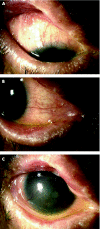The natural history of Stevens Johnson syndrome: patterns of chronic ocular disease and the role of systemic immunosuppressive therapy
- PMID: 17314145
- PMCID: PMC1954786
- DOI: 10.1136/bjo.2006.109124
The natural history of Stevens Johnson syndrome: patterns of chronic ocular disease and the role of systemic immunosuppressive therapy
Abstract
Objective: To characterize patterns of chronic ocular disease in patients with Stevens-Johnson syndrome (SJS) and its variant toxic epidermal necrolysis (TEN), and to describe their response to treatment.
Methods: Retrospective case series. A review of hospital records of 30 patients (60 eyes) with ocular manifestations of SJS or TEN was carried out. The principal outcome measure was to identify and classify the patterns of chronic ocular disease in SJS and TEN. The secondary outcome measure was the response to treatment.
Results: Patterns of chronic ocular disease observed after the acute episode included: mild/moderate SJS, severe SJS, ocular surface failure (SJS-OSF), recurrent episodic inflammation (SJS-RI), scleritis (SJS-S) and progressive conjunctival cicatrisation resembling mucous membrane pemphigoid (SJS-MMP). The median follow-up was 5 years (range 0-29). 19 patients (29 eyes (48%)) developed SJS-OSF, SJS-RI, SJS-S or SJS-MMP during follow-up. SJS-OSF was present in 12 patients (18 eyes (30%)). In 5 patients (eight eyes) this developed 1 year after the acute illness, without any further inflammatory episodes; it was associated with SJS-RI in 1 patient (2 eyes), with SJS-RI and SJS-S in 1 patient (1 eye), with SJS-S in 1 patient (1 eye) and with SJS-MMP in 4 patients (6 eyes). Episodes of SJS-RI occurred in 4 patients (7 eyes (12%)). The median time from acute disease to the first episode of SJS-RI was 8.5 years (range 5-63). SJS-S developed in 2 patients (4 eyes (7%)), of which 2 eyes subsequently developed SJS-OSF. SJS-MMP developed in 5 patients (10 eyes (16.6%)). The median duration from the acute stage to the diagnosis of SJS-MMP was 2 years (range 1-14). Immunosuppressive therapy successfully controlled inflammation in 10/10 patients with SJS-MMP, SJS-RI or SJS-S.
Conclusion: Ocular disease in SJS/TEN is not limited solely to the sequelae of the acute phase illness. Patients and physicians need to know that ocular disease progression, due to surface failure and/or acute inflammatory conditions, may occur at variable periods following the acute disease episode. Recognition of this, and prompt access to specialist services, may optimise management of these uncommon patterns of disease in SJS.
Conflict of interest statement
Competing interests: None.
Similar articles
-
Erythema multiforme, Stevens-Johnson syndrome, and toxic epidermal necrolysis: acute ocular manifestations, causes, and management.Cornea. 2007 Feb;26(2):123-9. doi: 10.1097/ICO.0b013e31802eb264. Cornea. 2007. PMID: 17251797
-
Ophthalmic Manifestations of Stevens-Johnson Syndrome and Toxic Epidermal Necrolysis and Relation to SCORTEN.Am J Ophthalmol. 2010 Oct;150(4):505-510.e1. doi: 10.1016/j.ajo.2010.04.026. Epub 2010 Jul 8. Am J Ophthalmol. 2010. PMID: 20619392
-
Ocular manifestations and complications of Stevens-Johnson syndrome and toxic epidermal necrolysis: an Asian series.Allergy. 2007 May;62(5):527-31. doi: 10.1111/j.1398-9995.2006.01295.x. Epub 2007 Feb 20. Allergy. 2007. PMID: 17313402
-
Stevens-Johnson syndrome and toxic epidermal necrolysis in patients with lupus erythematosus: a descriptive study of 17 cases from a national registry and review of the literature.Br J Dermatol. 2012 Mar;166(3):575-600. doi: 10.1111/j.1365-2133.2011.10705.x. Br J Dermatol. 2012. PMID: 22014091 Review.
-
[Ocular involvement in Stevens-Johnson syndrome and toxic epidermal necrolysis].Klin Monbl Augenheilkd. 2012 May;229(5):534-9. doi: 10.1055/s-0031-1299530. Epub 2012 May 16. Klin Monbl Augenheilkd. 2012. PMID: 22592345 Review. German.
Cited by
-
Long-term outcome and prognostic factor analysis for keratolimbal allografts.Graefes Arch Clin Exp Ophthalmol. 2011 Nov;249(11):1697-704. doi: 10.1007/s00417-011-1760-3. Epub 2011 Aug 12. Graefes Arch Clin Exp Ophthalmol. 2011. PMID: 21837442
-
A cross-sectional comparative study on chronic ocular manifestations of Stevens-Johnson syndrome and toxic epidermal necrolysis in Chinese eyes: a 15-year case series.Int Ophthalmol. 2018 Jun;38(3):1155-1160. doi: 10.1007/s10792-017-0576-5. Epub 2017 May 25. Int Ophthalmol. 2018. PMID: 28547534
-
A 26-year-old man with ocular complications after adverse reaction to phenytoin.Digit J Ophthalmol. 2016 Oct 4;22(4):82-84. doi: 10.5693/djo.03.2015.05.002. eCollection 2016. Digit J Ophthalmol. 2016. PMID: 28924410 Free PMC article. No abstract available.
-
Long-Term Effect of a Treatment Protocol for Acute Ocular Involvement in Stevens-Johnson Syndrome/Toxic Epidermal Necrolysis.Am J Ophthalmol. 2019 Dec;208:331-341. doi: 10.1016/j.ajo.2019.07.006. Epub 2019 Jul 19. Am J Ophthalmol. 2019. PMID: 31326519 Free PMC article.
-
[Ocular involvement in Stevens-Johnson syndrome and toxic epidermal necrolysis].Ophthalmologe. 2021 May;118(5):519-532. doi: 10.1007/s00347-021-01351-2. Epub 2021 Mar 16. Ophthalmologe. 2021. PMID: 33725172 German.
References
-
- Holland E J, Hardten D R. Stevens–Johnson syndrome. In: Pepose JS, Holland GN, Wilhelmus KR, eds. Ocular infection & immunity. St Louis, Missouri: Mosby, 1996416–425.
-
- Robin H, Hoang‐Xuan T. Fibrosing conjunctivitis. In: Hoang‐Xuan T, Baudouin Ch, Creuzot‐Garcher C, eds. Inflammatory diseases of the conjunctiva. Stuttgart: Thieme, 200173–95.
-
- Mondino B J. Cicatricial pemphigoid and erythema multiforme. Ophthalmology 199097939–952. - PubMed
-
- Pleyer U, Haberle H, Baatz H.et al Acute manifestations of oculo‐muco‐cutaneous disorders: erythema multiforme major, Stevens–Johnson syndrome, and toxic epidermal necrolysis. In: Pleyer U, Hartmann Chr, Sterry W, eds. Oculodermal diseases. Buren, The Netherlands: Aeolus Press, 1997169–191.



